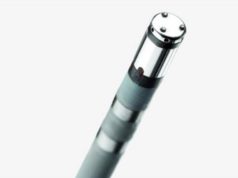
Findings of two studies investigating the use of a lattice-tip catheter for the treatment of atrial fibrillation (AF) were presented during a late-breaking trial session at AF Symposium (29–31 January, virtual) by Vivek Reddy (Icahn School of Medicine at Mount Sinai, New York, USA).
The lattice-tip catheter has an expandable lattice structure with a wide thermal footprint for the treatment of atrial flutter and AF, incorporating multiple surface thermocouples/mini-electrodes in high-resolution mapping and high-current temperature-controlled radiofrequency ablation (RFA).
The first of the two studies presented by Reddy at AF Symposium detailed the use of the lattice-tip device (Affera) in radiofrequency ablation for paroxysmal or persistent AF, and the effect of durable lesions on one-year freedom from atrial arrhythmias. The study was a non-randomised, first-in-human trial, which took place at three European centres, enrolling a total of 65 patients. At two of these centres, remapping procedures were performed to assess for lesion durability, Reddy explained.
In his introduction to the study, Reddy commented that the ideal lesion set remains controversial for both paroxysmal and persistent AF, and while there is some agreement that pulmonary vein isolation (PVI) should be performed as part of the procedure, the durability of PVI remains poor. He noted: “For paroxysmal AF it is unclear whether other atrial substrates should be targeted, or how frequently non-PV triggers should be targeted.”
Reddy added that for persistent AF, data is even poorer, stating that data from multiple studies suggest that only around 50% of patients remain in sinus rhythm. He questioned why this may be the case, speculating: “Is it because the lesions are bad or because additional lesion sets are needed? The reality is, because we do not know about the durability of the lesion sets it is hard to know what to do next.”
The lattice-tip catheter has shown good rates of durable isolation in first-in-human clinical studies, he said, and postulated that this may provide a better understanding of the efficacy of an anatomical ablation lesion set.
A total of 65 patients (mean age 62) were enrolled in the study and followed out to 12 months using both 48-hour Holter monitoring at three, six and 12 months, as well as additional monitoring for symptoms.
The ablation strategy included PVI in all patients and other linear lesions per the operator preference, Reddy explained, adding that importantly, there was no targeting of atrial substrates. In the paroxysmal AF group, half also received CTI ablation.
Detailing the outcomes, Reddy noted that for paroxysmal patients, the success rate was 97% and for those with persistent AF the figure stood at 92%.
“So, by virtue of the large thermal footprint and the unique tip characteristics, the lattice catheter created durable lesions both PVI and linear,” Reddy said, noting that this translated to a very low clinical recurrence rate.
“The question is: why?,” he went on to ask. “Is it simply that this was a small sample size and this is chance, or that the follow up was not intense enough and we need to use an implantable loop recorder?”
“The other possibility is that this is indeed real. Durable wide lesions with this catheter achieve [a] very high success rate. Clearly this needs to be studied in a larger trial, but we also have to take into account the potential for oesophageal damage. Perhaps the lattice based, RF approach anteriorly and PFA posteriorly might be superior.”
The second of Reddy’s two late-breaking abstracts documented the deployment of lattice-tip focal ablation of persistent AF, toggling between pulsed field (PF) and radiofrequency (RF) energy.
Using a lattice tipped catheter with radiofrequency energy, it is possible to rapidly move the catheter and achieve PVI as well as linear lesion placement with excellent durability, Reddy commented. Detailing a previous study, Reddy noted that using radiofrequency energy, PVI durability was above 90%, which translated to excellent freedom from arryhthmia recurrence.
“In our experience with RF we saw no safety events, but we know of course, that the oesophagus is nearby and the phrenic nerve is nearby.”
Latterly, Reddy added, there has been an “explosion” in interest in pulsed-field ablation—which carries the potential for minimal effect on the oesophagus.
“We considered the possibility that perhaps the lattice tip catheter should be used [with] both RF and PF. Radiofrequency energy in areas where we are not concerned about safety issues, and pulsed field energy in areas for example close to the oesophagus.
“With RF energy you see high temperatures, as one would expect, but with pulsed field energy, no significant increase in temperature.”
Reddy outlined the results from a non-randomised, first-in-human trial, enrolling 54 persistent AF patients (mean age 62) from three European centres.
The patients fell into two groups: the RF-PF group, receiving radiofrequency ablation energy anteriorly and pulsed field posteriorly at the oesophagus, and those for whom a PF-PF strategy was deployed, involving pulsed field energy used both anteriorly and posteriorly.
From a safety perspective, Reddy reported, there were no major complications such as tamponade, phrenic nerve paralysis, PV stenosis or oesophageal complications. Forty-four patients had endoscopy, and all showed no evidence of thermolesions.
Acute outcomes with a lattice tip catheter using a PF±RF strategy were just as efficient and safe for both PVI and for linear lesions, Reddy concluded. However, he noted that there are a number of limitations to the study, chiefly the small numbers of patients, operators and centres.
“There are a number of remaining questions—most importantly, will the lesion durability and will long-term clinical efficacy be as good what we saw with lattice RF,” he concluded.












